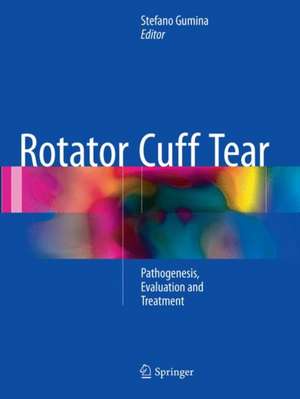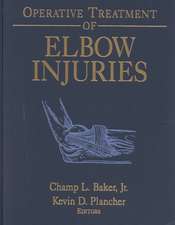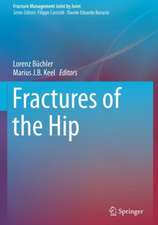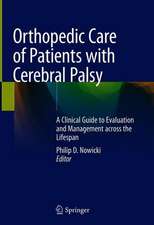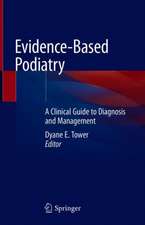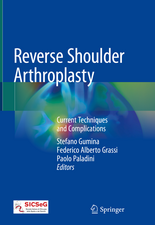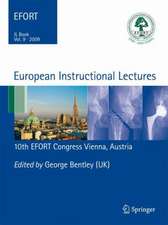Rotator Cuff Tear: Pathogenesis, Evaluation and Treatment
Editat de Stefano Guminaen Limba Engleză Paperback – 28 apr 2018
Rotator cuff tear has always attracted great interest because it may cause shoulder pain, loss of strength, simple or complex disabilities, and partial or total inability to work, reducing quality of life. The goals of cuff repair are to restore footprint anatomy with biomechanically secure, tension-free construction that promotes biological healing at the tendon-to-bone interface. Even today, there is cause for discussion about when and how to perform surgical repair and on what to do in cases of irreparable rupture.This book casts light on such issues. It is especially designed for shoulder surgeons and rehabilitation specialists and will also be of value for residents and shoulder fellows.
| Toate formatele și edițiile | Preț | Express |
|---|---|---|
| Paperback (1) | 937.11 lei 38-44 zile | |
| Springer International Publishing – 28 apr 2018 | 937.11 lei 38-44 zile | |
| Hardback (1) | 986.01 lei 38-44 zile | |
| Springer International Publishing – 23 noi 2016 | 986.01 lei 38-44 zile |
Preț: 937.11 lei
Preț vechi: 986.43 lei
-5% Nou
Puncte Express: 1406
Preț estimativ în valută:
179.34€ • 194.73$ • 150.64£
179.34€ • 194.73$ • 150.64£
Carte tipărită la comandă
Livrare economică 18-24 aprilie
Preluare comenzi: 021 569.72.76
Specificații
ISBN-13: 9783319814926
ISBN-10: 3319814923
Pagini: 438
Ilustrații: XXI, 438 p. 374 illus., 310 illus. in color.
Dimensiuni: 210 x 279 mm
Ediția:Softcover reprint of the original 1st ed. 2017
Editura: Springer International Publishing
Colecția Springer
Locul publicării:Cham, Switzerland
ISBN-10: 3319814923
Pagini: 438
Ilustrații: XXI, 438 p. 374 illus., 310 illus. in color.
Dimensiuni: 210 x 279 mm
Ediția:Softcover reprint of the original 1st ed. 2017
Editura: Springer International Publishing
Colecția Springer
Locul publicării:Cham, Switzerland
Cuprins
Section 1-Basic Science:1 History of shoulder pain and rotator cuff pathology. - 2 Subacromial space and rotator cuff anatomy.- 3 Rotator cuff.- 4 Epidemiology and demographics of the rotator cuff tear.- Section 2- Etiopathogenesis of the cuff tear: 5 Intrinsic factors (Physiologic degeneration – Aging- Smoking habit-Blood hypertension- Obesity, Hypercholesterolemia, and Diabetes – Genetics- Alchool assumption).- 6 Extrinsic factors (Subacromial impingement - Acromioclavicular joint degeneration- Thoracic hyperkyphosis - Subcoracoid impingement - Other causes: pigmented villonodular synovitis).- 7 Antropometrics aspects of the patients with rotator cuff tear.- Section 3-clinical and instrumental evaluation: 8 Classification.- 9 Shoulder Pain intensity and distribution,- 10 Clinical evaluation.- 11 Shoulder pain due to visceral pathologies and cervical spine disorders.- 12 Instrumental evaluation (X-Ray and MRI- Arthro CT- Ultrasound evaluation).- Section 4- cuff tear treatment:.- 13 Natural history.- 14 The possible role of the transcription factor NF-kB on evolution of rotator cuff tear and on mechanisms of cuff tendon healing.- 15 Conservative treatment.- 16 Operating room setting .- 17 Anesthesiological techniques.- 18 Treatment of the partial tears.- 19 Treatment of the reparable postero-superior lesions (Arthroscopic repair- single row and double row repair technique - Suture Bridge and Transosseous Techniques- Open technique).- 20 Treatment of the unreparable massive rotator cuff tear (Arthroscopic debridement-Margin Convergence- Interval slide- Partial repair- Subacromial Biodegradable Spacer- Tuberoplasty- Suprascapular nerve in association with irreparable tears- Augmentation with patches- Transfer of muscular tendineous units- Latissimus dorsi- Teres major- Pectoralis major for isolated subscapularis tear- Biceps Tenodesis Augmenting Repair).- 21 Subscapularis tear: intraoperative evaluation and treatment.- 22 Stem cells and PRP in rotator cuff healing.- 23 Rehabilitation.- Section 5-cuff tear arthropathy.- 24 Etiopathogenesis.- 25 Arthroscopic debridement.- 26 Reverse Shoulder Arthroplasty: evolution in design, indications, surgical technique, and associated complications.- 27 Nanostructures.
Notă biografică
Stefano Gumina, MD, PhD, is Professor in Orthopedics and Traumatology in the Department of Anatomy, Histology, Legal Medicine and Orthopedics and Traumatology at the Sapienza University of Rome, Italy. Since 2008 he has worked as an orthopedic surgeon, specializing in shoulder surgery, at the Clinic of Orthopedics and Traumatology, Sapienza University of Rome. His interest in shoulder disorders and surgery dates back to 1990 and is reflected by the publication of numerous papers in Italian and international journals. In 1997 he became an Associate Member of the European Society for the Surgery of the Shoulder and Elbow (ESSSE/SECEC). In 1999–2000 he served as the President’s Secretary of the Italian Society of Shoulder and Elbow Surgery (SICSEG) and in 2001 he was elected as a member of the Executive Committee of the society. In 2000 and 2001 he spent periods as a fellow at the University of Texas Health Science Center at San Antonio, the Cleveland Clinic Foundation, and the Rush Presbyterian-St Luke’s Hospital at Chicago. In 2001 he was nominated as an Ordinary Member of ESSSE/SECEC. In 2003 he obtained his doctorate in Physiopathology of the Skeletal Apparatus, focusing his attention on shoulder disorders. In September 2005 he organized in Rome, with Professor Postacchini, the 19th Congress of ESSSE/SECEC, and in 2006 he was nominated as a Corresponding Member of the American Shoulder & Elbow Surgeons. He is currently Vice President of SICSEG (Italian Society of Shoulder and Elbow Surgery).
Textul de pe ultima copertă
This handbook provides detailed, state of the art information on simple and complex rotator cuff tears that will be of value in daily clinical practice. It covers all relevant aspects, including basic science, pathogenesis, clinical and instrumental evaluation, and treatment techniques. Drawing on the results of recent studies, the book will enable the reader to better understand how tears occur and what treatment should be employed in different circumstances.
Rotator cuff tear has always attracted great interest because it may cause shoulder pain, loss of strength, simple or complex disabilities, and partial or total inability to work, reducing quality of life. The goals of cuff repair are to restore footprint anatomy with biomechanically secure, tension-free construction that promotes biological healing at the tendon-to-bone interface. Even today, there is cause for discussion about when and how to perform surgical repair and on what to do in cases of irreparable rupture. Thisbook casts light on such issues. It is especially designed for shoulder surgeons and rehabilitation specialists and will also be of value for residents and shoulder fellows.
Rotator cuff tear has always attracted great interest because it may cause shoulder pain, loss of strength, simple or complex disabilities, and partial or total inability to work, reducing quality of life. The goals of cuff repair are to restore footprint anatomy with biomechanically secure, tension-free construction that promotes biological healing at the tendon-to-bone interface. Even today, there is cause for discussion about when and how to perform surgical repair and on what to do in cases of irreparable rupture. Thisbook casts light on such issues. It is especially designed for shoulder surgeons and rehabilitation specialists and will also be of value for residents and shoulder fellows.
Caracteristici
Explains how rotator cuffs occur, drawing on the results of recent studies Describes clinical and instrumental evaluation Presents state of the art information on treatment techniques and their indications
